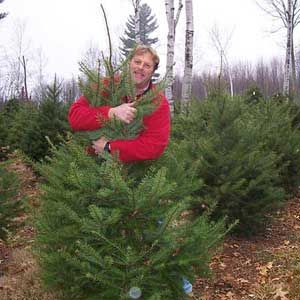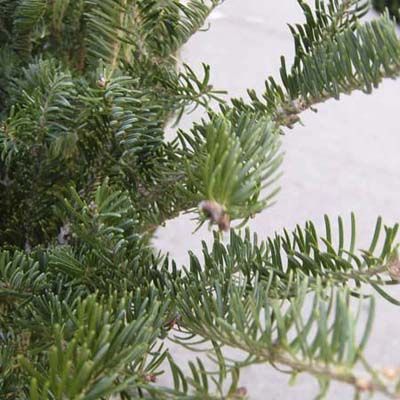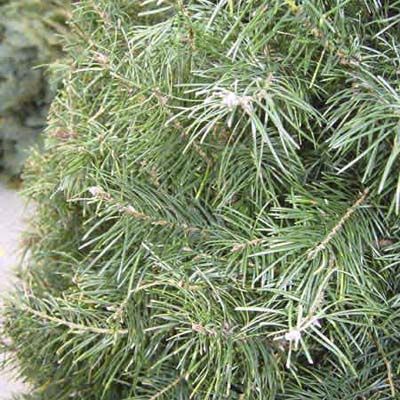
Christmas comes but once a year, and picking out the perfect tree to jolly up the living room is a family ritual full of fun and promise. But with all the different types of trees out there, it’s hard to know which one is right for your holiday display —and knowing how to keep it green and fragrant once you deck it out is a talent that eludes many a yuletide reveler. “When a tree goes south,” says formerThis Old House landscape contractor Roger Cook, “ninety-nine percent of the time, it’s human error.” So, before you turn your Tannenbaum into the Charlie Brown special, take a few tips from our experts on how to pick one, measure for it, and make sure it lasts through December 25 and maybe into the New Year.
How To Choose The Perfect Christmas Tree
When selecting your tree, consider factors such as tree species, size, and freshness to find the perfect centerpiece for your home.
Popular Christmas Tree Species
Different regions offer various Christmas tree species, each with unique characteristics:
- Balsam Fir: A Northeast classic with dark green needles and a strong fragrance
- Douglas Fir: Common in the Northwest but more expensive in the Northeast. It’s more portly in shape, with a paler green color, and soft needles—which make it child-friendly. However, the limbs are a bit dainty and will bend under heavy ornamentation.
- Fraser Fir: Popular along the East Coast, known for its bluish-silver underside and excellent needle retention. “It’s sort of a cousin to the balsam fir—very, very attractive needles,” says Roger.
- Scotch Pine: Hardy and popular in the Midwest, with soft, striped needles
- Arizona Cypress: Popular from North Carolina to Texas. It has a steel blue color with soft needles and a lemony mint aroma.
- Virginia Pine: A budget-friendly option in the South with a straight trunk and a classic pine scent. However, it has a lot of pitch, the natural resin that makes the branches and trunk sticky.
- Leyland Cypress: A good option for allergy sufferers, this tree has very little scent or pitch and a deep green color.
- Eastern White Pine: Common in the Mid-Atlantic states. It’s a basic, inexpensive pine that grows well at low altitudes.
- Scotch Pine: A hardy tree in colder parts of the Midwest that grows well near the Canadian border. It gets glowing recommendations for its soft, hairlike, striped needles and its ability to stand up well to transportation.
- Monterey Pine: A favorite in the Southwest, it’s deep green in color, has medium-length needles, and a bushy overall appearance.
- Colorado Blue Spruce: Popular in the West, especially around the Rocky Mountains. It has a rounded pyramid shape, which gives it a very full appearance. It has fragrant but sharp needles, and a silvery or bluish color.

Factors To Consider When Selecting a Tree
When choosing your tree, keep these factors in mind:
- Needle retention: Look for trees that hold their needles well.
- Fragrance: Consider how strong of a scent you prefer in your home.
- Branch strength: Ensure the tree can support your ornaments.
- Color: Choose a shade that complements your decor.
- Shape: Decide between a full, rounded tree or a more slender variety.

Where To Buy Your Christmas Tree
There are several convenient locales where you can buy your Christmas tree, such as:
Local Tree Farms
For the freshest trees, visit a local tree farm. These trees are grown specifically to retain their needles and are typically cut just three to four weeks before they arrive on the lot, usually the weekend after Thanksgiving, according to the late Clarke Gernon, former chairman of the National Christmas Tree Association.
Retail Lots
Many retail lots source trees from local farms, offering convenience and a wide selection.
Online Options
Some retailers now offer online ordering and delivery, providing a convenient option for those with busy schedules.
How To Inspect A Christmas Tree Before Purchasing
Before making your purchase, perform these simple tests to ensure you’re getting a healthy, fresh tree.
1. Test the branches. Grab any branch on the tree between your thumb and forefinger, gently clamp down and pull towards yourself. If you end up with a handful of needles, the tree is already past its prime.
2. Crush the needles in your hand and then check the scent. “If the tree doesn’t smell enough, don’t buy it,” says Roger.
3. Bounce the tree by holding it a few inches above the ground and dropping it. If the exterior needles fall off, it’s a sure sign of a bad apple. Needles that fall off from the interior of the tree are normal.
4. Make absolutely sure the tree’s trunk fits your stand. Trimming the diameter of the tree by cutting away the bark will strip the tree of its cambium layer, which absorbs water. If this happens your tree is a goner.
5. Before you tie up the tree, have the lot attendant put it through a shaker (if they have one—some farms use a blower, though a vigorous bounce will do as well). This will shake off any dead, interior needles. Don’t worry—it’s perfectly natural for an evergreen to have some dead needles on it from fall. Then have the tree sent through the baling machine to wrap it in netting for easy transport.

Setting Up Your Christmas Tree
Setting up your Christmas tree involves several important steps to ensure it remains healthy and stable throughout the holiday season.
Making A Fresh Cut
Before placing your tree in the stand, make a fresh cut at the trunk’s base. Use a pruning saw to remove at least an inch from the bottom, opening up the veins that will deliver water to the branches. You can have the lot do it before you leave if you’re headed for home, but you should wait if you’re going to be out more than four hours. Otherwise, the end will glaze over with new pitch, and the tree won’t take up water.
Choosing The Right Stand
Ensure your stand can accommodate your tree’s trunk diameter and is sturdy enough to keep it upright.
Most stands have small prongs in the bottom to hold the center of the tree. After the trunk has been cut, you may have to remove a few bottom limbs so that you can make contact with those prongs, and the bottom of the trunk rests on the bottom of the tree stand—if not, the tree could swing side to side. While the tree is still wrapped in mesh, place it on its side and use a rubber mallet to drive the stand’s prongs securely onto the trunk before tightening up the thumbscrews that hold the tree in the stand. Before tilting the tree vertically, set down some newspaper or an old rug under where the stand will be to catch any spilled water.
Proper Placement
Place your tree away from heat sources like fireplaces, radiators, and air vents. This will help prevent premature drying and reduce fire risks.
Watering Tips
Once the tree is upright, add clean water—a lot of it—as soon as possible. “People have to understand the first couple of days, the tree is going to suck up at least a gallon of water,” Cook says. The actual amount a tree can consume varies, so be vigilant the first two days, refilling when the stand gets low until the levels stay steady. Never let the water level drop beyond the cut end, or you run the risk of pitch forming, which will seal off the tree’s ability to absorb water. Roger also doesn’t see the need for any additives, like aspirin or plant food, as long as the water is clean and fresh.
Decorating Your Christmas Tree
Decorating your tree is a fun tradition for the whole family. Here’s how to do it safely and effectively.
Tips for Decorating Safely
With the tree upright and hydrated, cut off the mesh and spread out the branches. Most trees will settle and open up over a couple of hours, so you should wait to start hanging lights and ornaments. Then check all your lights for shorts and trouble spots before you string the tree, and never ever put the tree near the fireplace or lighted candles. A Christmas tree is just one flame away from a forest fire. Also, keep glass ornaments higher on the tree, especially in households with small children, who might knock them over and break them. Then enjoy your decorations for the duration, until it’s time to take everything down.
Recommended Decorating Order
- String lights from top to bottom.
- Add garlands or ribbons.
- Hang larger ornaments.
- Fill in with smaller ornaments.
- Place the tree topper last.
Sustainable Christmas Tree Practices
Sustainability is an important aspect to consider when selecting and disposing of your Christmas tree. Consider purchasing a potted tree that can be planted after the holidays, providing a sustainable alternative to cut trees.
Many communities offer tree recycling programs. Trees can be chipped for mulch or composted. Check with your local waste management department for specific guidelines and collection dates. Most towns won’t take trees that are wrapped in any inorganic material, like plastic disposal bags. So if you want to be neat about disposal, wrap the tree in craft paper before hauling it out to the curb.
Even after the holiday season, there are also creative ways to repurpose your Christmas tree. For example, you can cut the branches to use as ground cover in your garden or chop the trunk into small logs for natural edging around garden beds. You can also turn your Christmas tree into a habitat for wildlife in your backyard by placing it outside to provide shelter for birds and small animals during the winter months.
